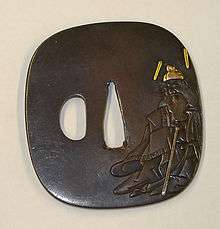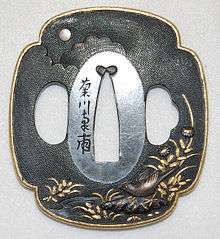Tsuba in the Collection of Wolverhampton Art Gallery

There are 114 tsuba in the Wolverhampton Art Gallery collection, with works ranging from the Momoyama Period to the end of the Edo Period. The tsuba were part of a wider collection of weapons and sword guards donated by Councillor Davis Green in October 1924. Originally the collection belonged to a Mr. C.E.F.Griffiths and was loaned to the gallery. The collection was reclaimed by the family, it is presumed that Mr. Griffiths died, and put it up for auction at Dudley Auction Rooms. Councillor Green bought the whole collection for £350 and donated it to the gallery.


Illustrated here is an example of a copper, nadekaku gata, kaku mimi tsuba in the Hamano Nara style. The nakago has copper sekigane. The design in katakiribori with gold inlay depicts the myth of Shoki and the demon [1] with Shoki on the upper side of the tsuba and a Demon on the reverse. The mei reads: Otsuryūken Masayuki.[2] Joly confirms that Masayuki is the same person as Shozui, an important founder member of the Hamano branch of the Nara School. Mr. Shinkichi Hara and Naunton have identified that Shozui also used the names Miboku and Otsuryūken. The dates for Masayuki are 1695-1796.[3]
During the Edo Period, 1603–1868, the Tokugawa Shogunate had a very strict dress code for attending the court. Samurai were required to wear kamishimo, or court dress. They wore the hakama, kimono and a special outer kimono with ‘wings’. Sometimes they wore a shorter version of the wakizashi, or short sword, called a kamishimozashi. The koshirae for the sword was also very precise. All the fittings were made of shakudo with a Nanako ground. The designs were also formal and consisted of flowers, family crests, the crest of a daimyo, kiri blossom (paulownia flowers), or a dragon in clouds. The shakudo mokko gata tsuba with gold fukurin mimi shown here is typical of the kind of tsuba designed for use at court. Its small size means it was made to fit a wakizashi. It has a takabori design of a bird with foliage and flowers on a nanako ground. It is from the Kikugawa School popular during the latter part of the Tokugawa Shogunate. The omote mei reads Kikugawa Nampo, who is known to have been practicing during the later half of the nineteenth century. He was a pupil of Muneyoshi, who acquired the nickname Kikubori-Chōbei[4] because of his skill carving chrysanthemums. Later he studied the work of Chizuka-Hisanari.


References
- ↑ Joly, Henri (1908). Legend in Japanese Art. Kegan Paul. pp. 474–475.
- ↑ Joly, Henri (1985). Shosankenshu. Holland Press. pp. M302/303.
- ↑ Gunsaulis, Helen (1923). Sword Mounts in the Field Collection. Field Museum of natural History, Chicago. p. 92.
- ↑ Okabe, Kakuya. Museum of Boston Japanese Sword Guards. Boston Museum.